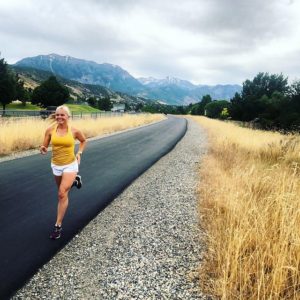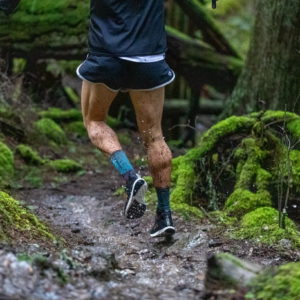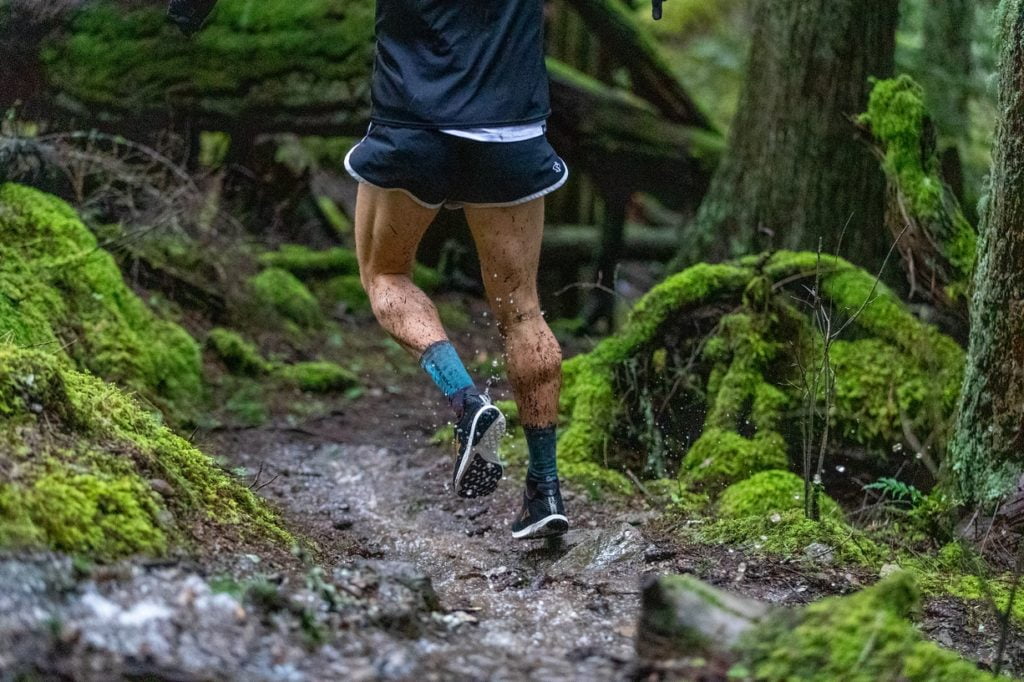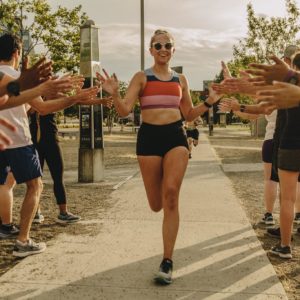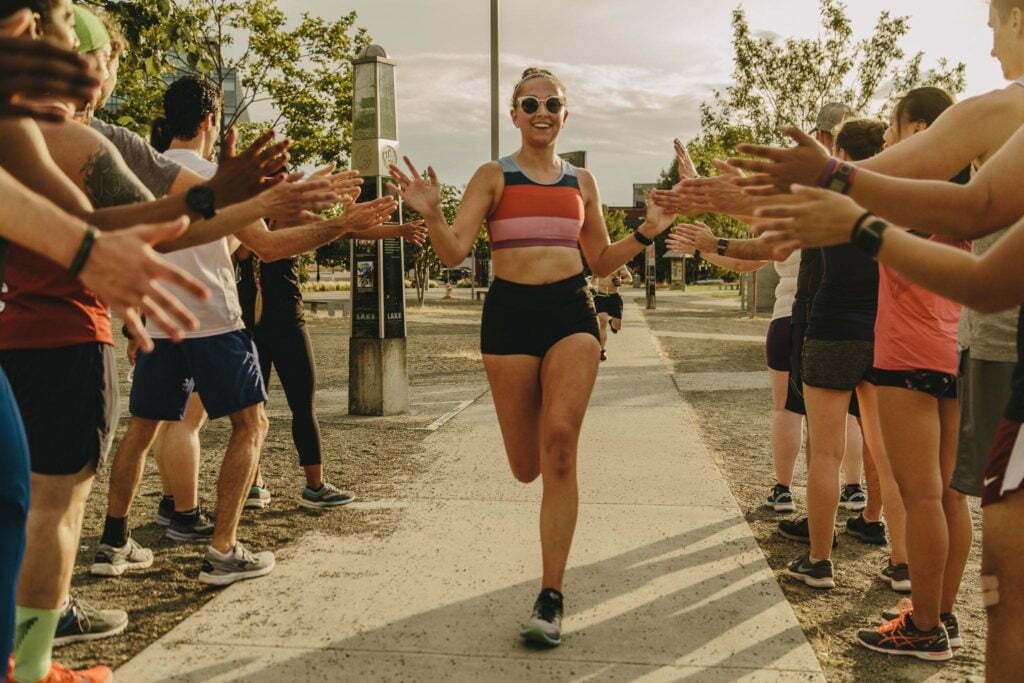I love apps. I’m constantly searching to find the completely perfect software that will help me plan, organize, or track any aspect of my life and therefore make me a more organized person with minimal effort on my end. Running has me at my pickiest when it comes to selecting apps. I’ve tried them all on my quest to find the one app that provides me with my personally ideal balance of tracking my runs, showing me my data and metrics (not too many numbers, but not too few either), connecting me with other runners, planning routes, keeping me healthy, etc. etc. etc. Spoiler alert: it doesn’t exist. There is not one app to rule them all (not that I haven’t asked my friends who code how hard it would be to create one), and letting apps do all of your thinking for you, especially with running, isn’t necessarily going to create the best results for everyone. Our brains do need to be involved, it turns out. However – apps are fun and can be really helpful tools both in understanding our training and in growing our running community. Here are the ones that I think are essential. Let this be your Starter Pack for running apps!
General Run Tracking
STRAVA (free, premium subscription available. Apple/Android)
If you are only going to download one running app, let it be Strava. Providing both function and social connection, Strava is like homebase for runners. At its core, Strava is a hub where you can track or upload runs and analyze your training. Track your mileage, keep up with your trends, track the mileage on your shoes, and keep a log of your runs to look back on. With a premium subscription, set monthly and yearly mileage goals, get access to additional training insight and tracking, and map out custom routes.
Strava offers a lot beyond the technical though. Most GPS watch companies might offer a social element within their apps where you can see what other runners are doing, but I find that a) not a lot of people actually use these features and b) you can only view the runs by people with the same watch brand as you. Strava offers a similar feature, but it’s actually used! And it’s used by a lot of people! If you run with a group or keep in touch with other runners, it’s a great way to see their runs and give them some love in the form of “kudos.” Essentially, it’s a social media for runners, and runners love to cheer each other on. If your personal running community isn’t booming yet, you can also connect with running groups and participate virtually. There are so many features to check out and so many different ways that you can use the app so that it meets your personal needs, and the other good news is that they keep adding more.
Note: Are you wondering if the premium feature is worth it? If you’re considering it for the additional metrics and training insight and you already run with a GPS watch, chances are the insight that you get from your watch will be more than enough. However, I think it’s worth it for the route mapping features, its live-tracking feature called Beacon (great for safety), and for its collaboration with another app called Recovery. I’ll talk about Recovery a bit later, but it comes free with your premium Strava subscription. Read more here on Premium.
ALLTRAILS (free, premium subscription available. Apple/Android)
Trail runners, be excited! AllTrails is your best bet for finding new trails to run or navigating the ones you already love. It has a database, both from maps and crowdsourced by users, of trails and trail segments for you to plan your runs. Trail running is amazing but there are certainly more logistics. AllTrails makes it easier. Before you go out, you can see all sorts of information about where you’ll be running. Is there easy parking? Are dogs allowed? How is the terrain? Users often even upload pictures so you can get a visual idea of what you have to look forward to. It also has a great mapping feature so that you can create your own route, both for your own use or to add to the database for future runners to find and use. AllTrails also does a really great job with navigation. If you run with your phone or a smart watch that supports the app, it will let you know if you go off-route. The navigation from the app is known to drain your battery, but if you plan ahead and download your route beforehand you’ll be in good shape.
TEMPO FOR RUNNERS (free, premium subscription available. Apple only)
This one is only for iPhones, and it’s a relatively newer and maybe less popular app for tracking and understanding your training. On the surface, it’s going to do a lot of the same things that Strava or your GPS watch apps will do. So what makes it special?
I use Tempo for exactly one thing: simplicity. Remember how I mentioned earlier that I wanted to make an app for myself that was exactly what I needed? That’s what the guy who made Tempo did. He made it for himself based on how he wanted to see his data, and then he published it just in case it worked for other people too. Tempo is a really great tool if you’re someone who keeps a detailed running log or journal. It uses tags to easily categorize entries, has a section for notes where you can keep track of general thoughts that aren’t specific to any workouts, and there is no sharing or social element – your thoughts are just for you. It’s also pretty beautiful. The app is streamlined to show any information that you may need right at the top of the screen – weekly, monthly, and yearly mileages for starters.
My favorite feature and the reason I have Tempo, though, is the cumulative graph. Sometimes you just want to see your mileage over a long period of time, and the graphs let you look at your mileage in a way that just makes sense. It’s everything you get from some of these other apps, but it’s reorganized in a simple and matter-of-fact way. It’s definitely one to consider if you don’t need the fluff and just want the data.
RECOVER ATHLETICS (free, premium subscription available or included with Strava Premium. Apple/Android)
Injury prevention can be hard to figure out, but Recover Athletics has teamed up with Strava and is trying to help. You get all of the features with a Strava subscription, and I recommend this route. Recover offers pre-run, post-run, and anytime workouts that promote mobility, stability, and strengthen parts of the body that tend to fall victim to overuse injuries. If something is already bothering you, tell the app and it will give you a program to assist you in rehab or staving off injury. Workouts are anywhere from 5 to 25 minutes long. The best part of this app, though, is actually its push notification system. Because it links to Strava, it knows when you finish a run. Before you can even take your shoes off, this app will buzz your phone. “Hey! You just finished a run! Why don’t you do some mobility real quick?” Let me tell you folks – its timing is great and it works.
Honorable Mentions
NIKE RUN CLUB (free, Apple/Android)
Nike Run Club is a favorite among many people who track their runs using an Apple Watch (although it’s also available for Android). Apple even has a Nike specific watch that’s pretty integrated with it. Nike Run Club is a great option for run tracking and even offers many guided runs based on what your workout or mood is. Beyond that, they have a social element that’s fueled by global challenges and leaderboards. Their “Events” tab links you with Nike Run Club locations in your area to get you connected. If you’re an Apple Watch user or someone who likes to run with a (virtual) voice in your ear keeping you moving, you might like NRC.
MAPMYRUN (free, premium subscription available. Apple/Android)
Similar to Nike Run Club, this is Under Armour’s foray into the running app game. You’re going to see a lot of the same features (run tracking, social challenges and leaderboard, etc.), but MapMyRun also has a pretty intuitive route mapping feature available on its desktop site. You can access these routes from the app after you’ve made them on a web browser. There is a premium subscription that offers live tracking, training plans, and more insight into metrics, but if you’re already using Strava or getting data from your running watch, the premium features may not be worth it.
ZWIFT (free, Apple/Android)
Zwift is probably most popular for its virtual cycling, but if you’re a treadmill runner you may like this. Download Zwift and connect it to your treadmill, and you can watch yourself (read: a digitally created little version of yourself) run through beaches, volcanoes, and forests while your real self sets the pace on the treadmill. Increase your treadmill speed, you’ll see your character speed up. Connect with other runners who are virtually running alongside you and have fun!
RUNGAP (free, paid subscription available, Apple only)
If you are overwhelmed with apps and for some reason one of them isn’t uploading information to another the way it should, RunGap is your friend. I used this the most when I ran with my Apple Watch. I found it easy to upload workouts to Strava, but some apps just didn’t seem to want to communicate with the watch or Apple Health. RunGap reads any data that you ask it to and can upload it to the app of your choice. I used it often when my Apple Watch refused to upload directly to Final Surge (another app that didn’t make this list but is frequently used by coaches to upload training plans and communicate with their athletes). RunGap would read the Apple Watch workout and I would send it to Final Surge. It’s a great workaround when technology just doesn’t seem to cooperate.
Cross Training
I know we’re talking about running, but here are a few bonus apps that have really come in handy with strength training, which can be very useful for runners.
FITBOD (free, paid subscription required, Apple/Android)
If you have ever struggled with putting together a strength training workout, you will love FitBod. You tell it what you want to work out and what equipment you have available, and it will put together an easily modifiable workout for you. Each exercise has a clear demonstration of how to perform it, and the cool part is that as soon as you’re done, FitBod will remember what you worked out. The next time you ask it for a workout, it will recommend training that targets muscles that are rested while allowing recently worked out muscles time to recover. It will also gradually increase your number of reps or amount of weight that it recommends based on past performance. It basically takes all of the thinking out of strength training for you, while still allowing for flexibility if you prefer your brain’s ideas over the app’s.
DOWNDOG (free, paid subscription required, Apple/Android)
I’m new to yoga in my cross training, and this app made it so easy. It puts together fully customizable yoga sessions based on what you want to target, how long you have, the music and instructor voice you prefer, speed, difficulty, and the amount of instruction you want to receive. It’s the yoga beginner’s dream. They also have versions for HIIT, Meditation, Running, Barre, and Prenatal Yoga. One subscription gives you access to all of these.
PELOTON (free, paid subscription required, Apple/Android)
Whether or not you own Peleton equipment, this app provides a lot of great strength training and stretching workouts specific to runners. Use their guided runs for some encouragement, or work their massive library of strength training into your routine. It’s a great option for runners no matter what you’re doing.
JUST 6 WEEKS (free, paid subscription available, Apple/Android)
If you’ve ever wanted to get better at pushups, this app is a great one to download and use a few times a week. Through multiple sets with super low reps that increase every day that you use the app, it builds your pushup endurance over time. Without the subscription, you have access to the pushup challenge with ads. If you choose to pay for the subscription, it uses the same model for other exercises. It’s a great option for some bare-bones strength training.
There you have it! There are so many options out there for apps that support and influence your running journey, and I’m sure I didn’t even scratch the surface. Do some exploring of your own and I’m sure you’ll find some that meet your needs! Hopefully this list helps you get started. Happy Running!
Hannah Breedlove is a coach with Team RunRun. To learn more about her or to work with her, check out her coach profile.














